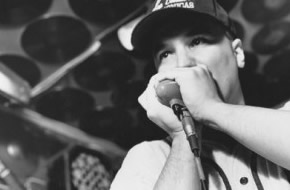Crossing The Bridge
 In cross-harp (2nd position) it is easy to limit your playing to blues patterns between holes 1 and 6. Accepted, some songs require this, focusing on the wealth of ‘low end’ bends, moods and tones. But what do we do with the ‘top end’ of the harp? It’s banjo country and it’s scary – you just don’t want to go there! This is because the tuning sequence changes in holes 7 to 10 and cross-harp patterns have to change with it. Those favoured low end formulae are rendered useless as everything seems to reverse or shift. Remember how mysterious the low end was when you first picked up the harp? Time, determination, experiment and the sense of adventure all spurred you on to greater things. Breaking into the top end is no different. So it’s back to school…
In cross-harp (2nd position) it is easy to limit your playing to blues patterns between holes 1 and 6. Accepted, some songs require this, focusing on the wealth of ‘low end’ bends, moods and tones. But what do we do with the ‘top end’ of the harp? It’s banjo country and it’s scary – you just don’t want to go there! This is because the tuning sequence changes in holes 7 to 10 and cross-harp patterns have to change with it. Those favoured low end formulae are rendered useless as everything seems to reverse or shift. Remember how mysterious the low end was when you first picked up the harp? Time, determination, experiment and the sense of adventure all spurred you on to greater things. Breaking into the top end is no different. So it’s back to school…
Stick with it – there’s fun and satisfaction to be had. In due course, 3rd position will have you skipping across the divide like a spring lamb, oblivious to worldly perils. For now, the first steps in linking the bottom and top ends are what we call ‘crossing the bridge’ exercises. Try out these helpful 2nd position licks:
Tab key: 3D is a draw note, 4B is a blow note, ‘ is first bend, ” is second bend, ‘” is third bend
The bridge
4D 5B 6B 7D 6B 5B 4D
Variations
4D 5B 4B 5B 6B 7D 6B 5B 4B 5B 4D
4D 5B 4D 5B 6B 7D 6B 5B 4D 5B 4D
4D 5B 4D 5D 6B 7D 6B 5D 4D 5B 4D
A cool run up
4D..4D 5B..6B 7D..8D..8B 9B..8B..9B 10B.. 10B”~
A cool run down
7D 6D 6B 5B 4D 5B 3D’..3D” 2D 2D…2D’
A cool run up and down
6B 7D..7D…. 6B 7D 8D 8B 7D 6D 6B 5B 4D 3D 3D..3D”..2D 3D-4D 3D-4D
Another route down (in couplets)
9B..9B 9D..9D 8D..8D 7D..7D 6B..6B 5D..5D 4D..4D 3D..3D 2D..2D 2D”..2D” 1D..1D 1B..1D..2B…2B”
Jerry Portnoy’s run down in Real Gone Guy
7D 7D 6B 6B 5D 5D (4D) 4B 4B
Now try the 2nd position blues scale right round the harp and back again!
2D 3D’ 4B 4D’ 4D 5D 6B 7D 78 8D 9D 9B 10B’ 10B 1D’ 1D 2D” 2D
Practise it in both directions.
And this excellent exercise playing thirds up and down
4B..5B 4D..5D 5B..6B 5D..6D 6B..7D 6D..7B 7D..8D..7B
7B..6D 7D..6B 6D..5D 6B..5B 5D..4D 5B..4B 4D..3D..4B
What next?
Listen to other players and trade ideas. Listen to the masters and note where they cross the bridge. Jimmy Reed’s playing sounds squeaky and unsophisticated at first, but closer inspection will reveal some handy moves in first and second position. Charlie McCoy will show you the country route. Rory McLeod will have you weaving back and forth Mexican style. Of course you can investigate Popper too…but wear safety gear and shut the door.
Third position
This is new territory for beginners and intermediates, but nothing to be scared of. While there are plenty of notes in third position at the low end, they involve accurate direct bending and are better explored having first established the main patterns upward from draw 4.
Start by mapping out Scarborough Fair from draw 4, or Drunken Sailor from draw 6. It may appear tame at first, but it’s the basis to third position and extending your range. And it’s what won The Good Doctor the UK national championship, so don’t dismiss it!
Scarborough Fair
4D 4D 6D 6D 5B 5D 5B 4D
6D 7B 8D 7B 6D 7D 6B 6D
8D 8D 8D 7B 6D 6D 6B 5D 5B 4B
4D 6D 6B 5D 5B 4D 4B 4D
Drunken Sailor
6D 6D..6D..6D 6D..6D..6D 4D 5D 6D
6B 6B..6B..6B 6B..6B..6B 4B 5B 6B
6D 6D..6D..6D 6B 6D 7D 7B 8D
7B 6D 6B 5B 4D 4D
